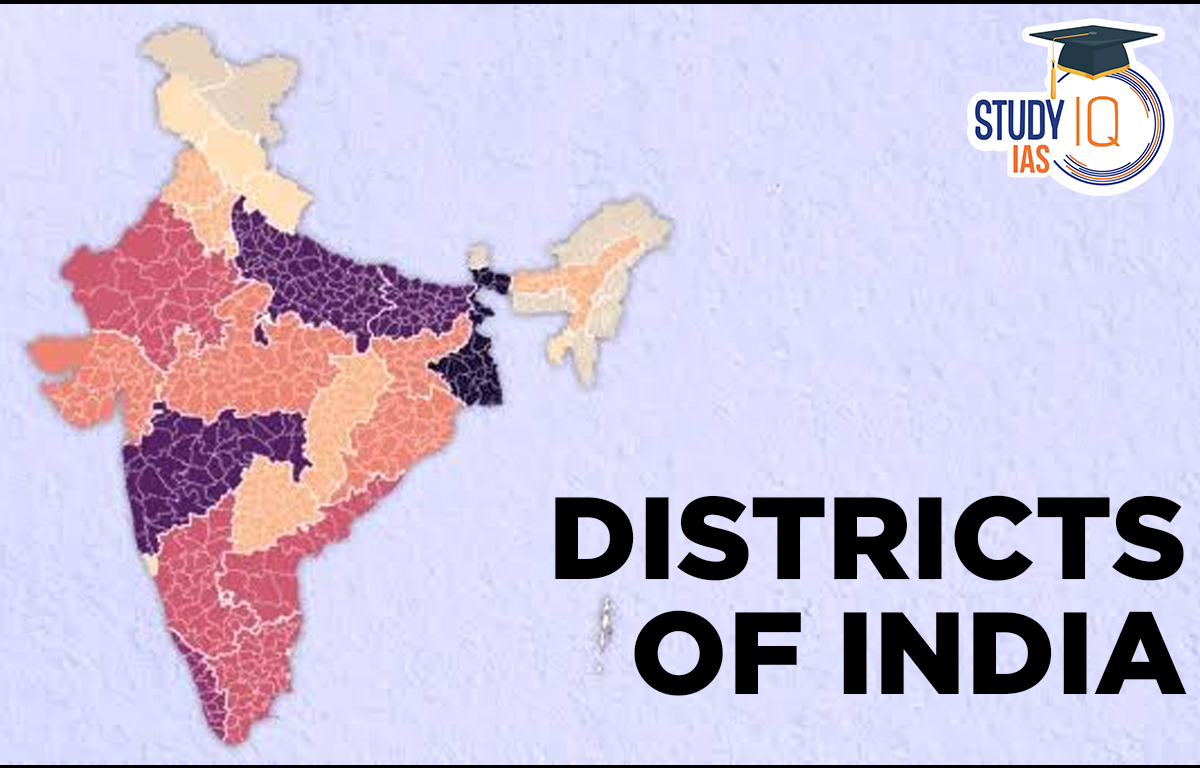Table of Contents
India is administratively divided into states and union territories (UTs), which are further segmented into districts. Districts of India play a vital role in local governance, administration, and public service delivery, making them an essential topic for UPSC aspirants. India, a large and multi-faceted country, is geographically organised into many districts, which are the basic building blocks of governance and local administration.
These Districts of India, with their particular socio-economic and cultural features, are the first level at which government policies are executed and public services are provided to the citizens. Understanding the list of districts in India, their unique features, and recent updates can strengthen one’s grasp of India’s administrative geography and help in exams like UPSC, which often include questions on India’s socio-administrative divisions.
What is a District?
A district is the primary administrative division within an Indian state or UT. Governed by a District Magistrate (DM) or District Collector, each district functions as a semi-autonomous administrative unit responsible for implementing government policies, law and order, revenue collection, and development activities. Each district is further divided into talukas, tehsils, or subdivisions.
Current Number of Districts in India
- Total number of districts: Around 800
- Source for data: Government of India’s Local Government Directory
- Key states with high district count: Uttar Pradesh, Rajasthan, Tamil Nadu
Importance of Districts in Governance
Districts are crucial in Indian governance for multiple reasons:
- Law and Order Maintenance: Each district has its law enforcement agency, including police and judicial administration.
- Revenue Collection: Districts manage land records and revenue collection through a network of local officers.
- Public Welfare Schemes: Districts play a role in implementing central and state government welfare schemes at the grassroots level.
- Disaster Management: District administration is at the forefront during natural calamities, coordinating relief and recovery efforts.
List of State-wise Districts of India
Uttar Pradesh has the highest number of districts, with a population of 199,812,341, and Goa has the lowest number of districts, with 2 districts with a population of 1,458,545. Check here List of State-wise Districts of India along with their population.
| Number of districts in each state or UT | |||
| S.No. | State/Union Territory | No. of districts | Population |
| 1 | Uttar Pradesh | 76 | 199,812,341 |
| 2 | Madhya Pradesh | 57 | 72,626,809 |
| 3 | Rajasthan | 55 | 68,548,437 |
| 4 | Bihar | 38 | 104,099,452 |
| 5 | Tamil Nadu | 38 | 72,147,030 |
| 6 | Maharashtra | 36 | 112,374,333 |
| 7 | Assam | 35 | 31,205,576 |
| 8 | Gujarat | 33 | 60,439,692 |
| 9 | Telangana | 33 | 35,003,674 |
| 10 | Chhattisgarh | 33 | 25,545,198 |
| 11 | Karnataka | 31 | 61,095,297 |
| 12 | West Bengal | 30 | 91,276,115 |
| 13 | Odisha | 30 | 41,974,218 |
| 14 | Andhra Pradesh | 26 | 49,577,103 |
| 15 | Arunachal Pradesh | 26 | 1,383,727 |
| 16 | Jharkhand | 24 | 32,988,134 |
| 17 | Punjab | 23 | 27,743,338 |
| 18 | Haryana | 22 | 25,351,462 |
| 19 | Uttarakhand | 17 | 10,086,292 |
| 20 | Manipur | 16 | 2,570,390 |
| 21 | Nagaland | 16 | 1,978,502 |
| 22 | Kerala | 14 | 33,406,061 |
| 23 | Himachal Pradesh | 13 | 6,864,602 |
| 24 | Meghalaya | 12 | 2,966,889 |
| 25 | Mizoram | 11 | 1,097,206 |
| 26 | Tripura | 8 | 3,673,917 |
| 27 | Sikkim | 6 | 610,577 |
| 28 | Goa | 2 | 1,458,545 |
List of Districts in Union Territory
Jammu and Kashmir has the highest number of districts, with a total of 20 total of 12,258,093, and Lakshadweep has with lowest number, with 1 district with a total population of 64,473.
| Number of districts in each Union Territory | |||
| # | Union Territory | No. of districts | Population |
| 1 | Jammu and Kashmir | 20 | 12,258,093 |
| 2 | Delhi | 11 | 16,787,941 |
| 3 | Puducherry | 4 | 1,247,953 |
| 4 | Ladakh | 4 | 290,492 |
| 5 | Dadra and Nagar Haveli and Daman and Diu | 3 | 586,956 |
| 6 | Andaman and Nicobar Islands | 3 | 380,581 |
| 7 | Chandigarh | 1 | 1,055,450 |
| 8 | Lakshadweep | 1 | 64,473 |
Largest and Smallest Districts of India
- Largest district: Kutch, Gujarat, with an area of 45,652 km2
- Smallest district: Mahé, Puducherry, with an area of 8.69 km2
- Most populated district: North 24 Parganas, West Bengal, with a population of 10,082,852
- Least populated district: Dibang Valley, Arunachal Pradesh, with a population of 8,004
Largest District in India
Gujarat’s Kachchh district is the largest in India. Pakistan borders it to the north and northwest, while Rajasthan State borders it to the northeast. The district’s overall area is 45,674 square kilometres, or 23.27% of Gujarat’s entire geographic area.
Smallest District in India
Mahe is one of the four districts in the Indian union territory of Puducherry. It encompasses the entire Mahé region. Mahé is India’s tiniest district in terms of area. North Malabar in Kerala State encircles the entire Mahé district.
How Many Districts in India in 2025?
Currently, there are approximately 780 to 806 districts across India’s 28 states and 8 Union Territories. This number has been steadily increasing in recent years due to the creation of new districts for better administration and development. The number of districts in India can change over time. For example, Madhya Pradesh will add three new districts, increasing the total number from 52 to 55.
Most Populated District in India
As of the 2011 census, the most populated district in India was Thane, Maharashtra, with a population of 11,060,148. The least populated district was Dibang Valley, Arunachal Pradesh, with a population of 8,004. The most populated states in India are Uttar Pradesh, Maharashtra, and Bihar. Based on the 2011 Census, here are the top 10 most populous districts in India:
| S.No. | District | State |
Population (lakhs)**
|
| 1 | Thane | Maharashtra | 11,060,148 |
| 2 | North 24 Parganas | West Bengal | 10,082,852 |
| 3 | Bangalore | Karnataka | 9,588,910 |
| 4 | Pune | Maharashtra | 9,426,959 |
| 5 | Mumbai Suburban | Maharashtra | 9,332,481 |
| 6 | South 24 Parganas | West Bengal | 8,153,176 |
| 7 | Barddhaman | West Bengal | 7,723,663 |
| 8 | Ahmedabad | Gujarat | 7,208,200 |
| 9 | Murshidabad | West Bengal | 7,102,430 |
| 10 | Jaipur | Rajasthan | 6,663,971 |
The State governments are in charge of creating new districts, altering current districts, or eradicating existing districts. Either an executive order or a bill passed by the State Assembly can establish a new district. Numerous States favour the executive method, which involves merely publishing a notification in the official gazette.
In the modification or formation of new districts, the Centre has no involvement. The choice is up to the state. When a State wants to modify the name of a district or a railroad station, the Home Ministry is involved. The state government’s request is approved by the departments, including the Ministry of Earth Sciences, the Intelligence Bureau,the Department of Posts, the Geographical Survey of India, and the Railway Ministry. After reviewing their responses, the state government will be given a certificate of no objection.
Conclusion
India’s districts, spread across diverse states and regions, are the backbone of its administrative framework. With varying population densities and geographic sizes, each district contributes uniquely to the country’s social, economic, and cultural landscape. Understanding the intricacies of India’s districts is essential for grasping the complexity and diversity of the nation.


 Weapons Used in Operation Sindoor: SCALP...
Weapons Used in Operation Sindoor: SCALP...
 Baglihar Dam & India's Hydroelectric...
Baglihar Dam & India's Hydroelectric...
 List of Military Operations of India, Na...
List of Military Operations of India, Na...





















